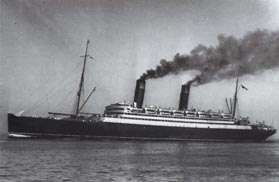RMS Caronia (1904)
RMS Caronia was a British ocean liner, launched on 13 July 1904. She was built for Cunard[1] by John Brown & Co. of Glasgow. She was the only ship in the Cunard fleet to be named after an American, being named after Caro Brown, granddaughter of Cunard's New York agent.[2] She left Liverpool on her maiden voyage to New York on 25 February 1905. A successful 1906 cruise from New York to the Mediterranean led to Caronia being used for cruising frequently in the coming years.
 Caronia under steam | |
| History | |
|---|---|
| Name: | RMS Caronia |
| Namesake: | Caro Brown |
| Owner: | Cunard Line |
| Builder: | John Brown & Company, Clydebank, Scotland |
| Yard number: | 362 |
| Launched: | 13 July 1904 |
| Maiden voyage: | 25 February 1905 |
| Homeport: | Liverpool |
| Fate: | Sold for scrapping, 1932 |
| General characteristics | |
| Tonnage: | 19,524 GRT |
| Length: | 678 ft (207 m) p/p |
| Beam: | 72 ft (22 m) |
| Propulsion: | Steam quadruple-expansion engines, twin propellers |
| Speed: | 18 knots (33 km/h; 21 mph) |
| Capacity: |
|
On 14 April 1912 Caronia sent the first ice warning at 09:00 to RMS Titanic reporting "bergs, growlers and field ice".
Caronia was briefly placed on Cunard's Boston service in 1914, but the start of the First World War caused her to be requisitioned as an armed merchant cruiser. She was stationed off New York on contraband patrol.[2] In 1916, she became a troopship and served in that role for the duration. Her last duties being the repatriation of Canadian troops in 1919.[2] She returned to the Liverpool – New York run after the war.
In 1920 Caronia was converted to burn oil instead of coal.
After returning to service, she sailed on a number of different routes, including:
- Liverpool – New York/Boston
- London – New York
- Hamburg – New York (1922)
- Liverpool – Quebec (1924)
- New York – Havana
Her last voyage, from London to New York was on 12 September 1932, after which she was sold for scrap. Initially sold to Hughes Bolckow for demolition at Blyth, Northumberland, she was resold, renamed Taiseiyo Maru and sailed to Osaka, Japan, where she was scrapped in 1933.
Turbine experiment
Caronia was fitted with the older quadruple-expansion engine technology; whilst Carmania had turbines and proved to be the more economical of the two liners.[1]
References
- "Caronia". Archived from the original on 12 August 2010. Retrieved 15 July 2010.
- Wills, Elspeth (2010). The Fleet 1840-2010. London: Cunard. p. 141. ISBN 978-0-9542451-8-4.
Bibliography
- Osborne, Richard; Spong, Harry & Grover, Tom (2007). Armed Merchant Cruisers 1878–1945. Windsor, UK: World Warship Society. ISBN 978-0-9543310-8-5.
- Haws' Merchant Fleets
- Bonsor's North Atlantic Seaway
External links
| Wikimedia Commons has media related to Caronia (ship, 1905). |